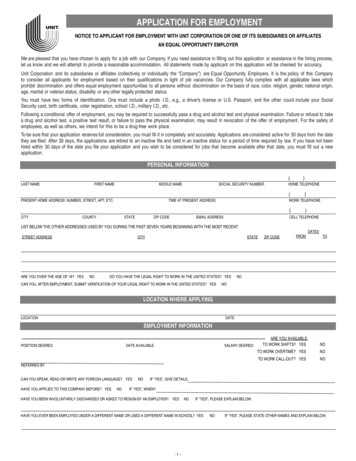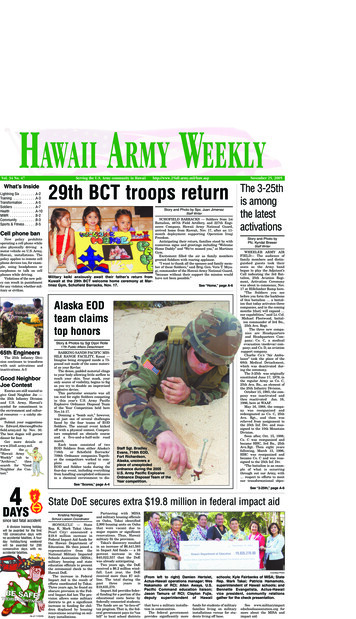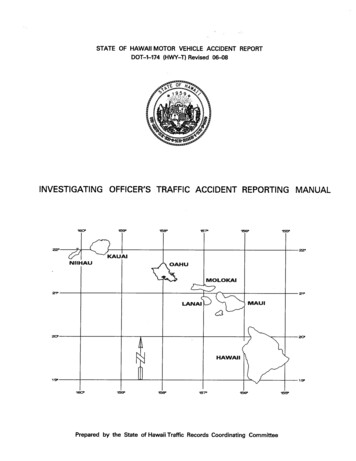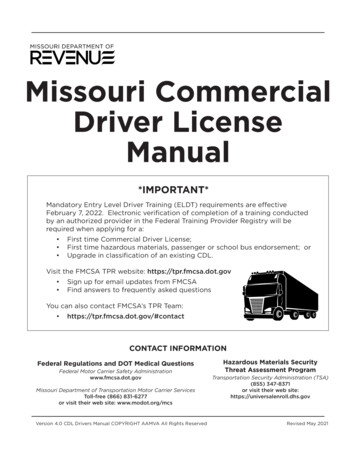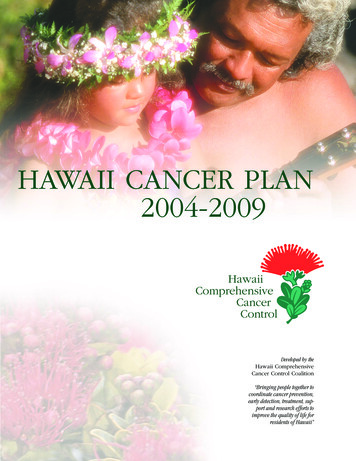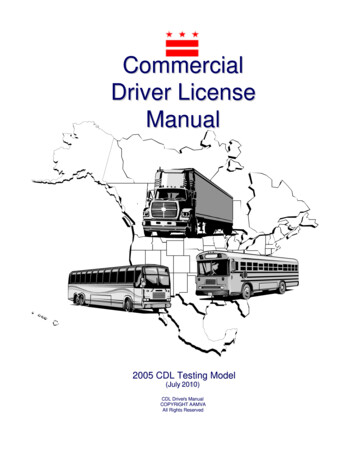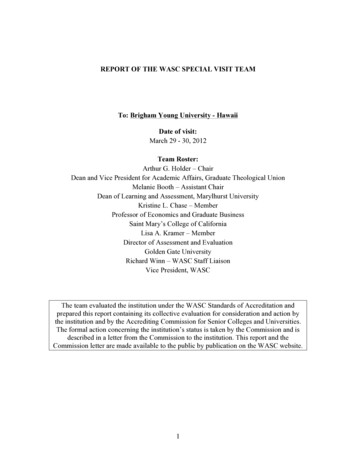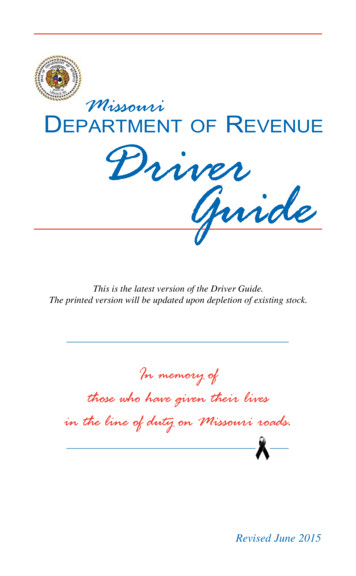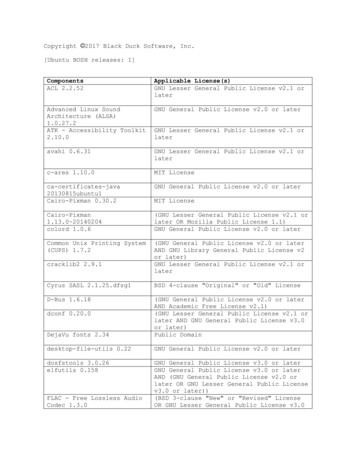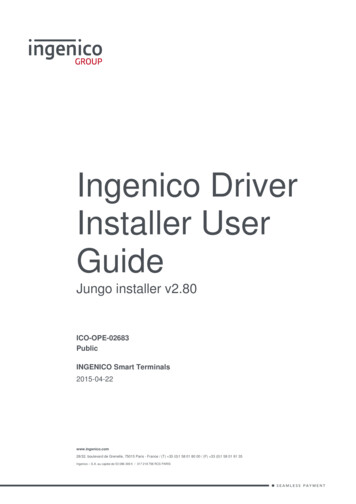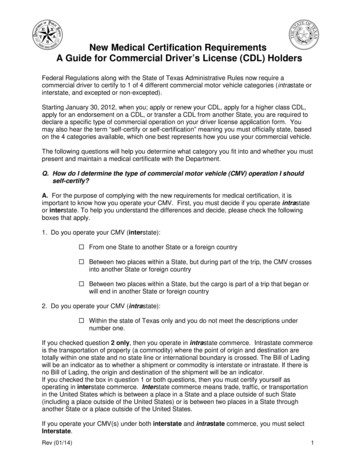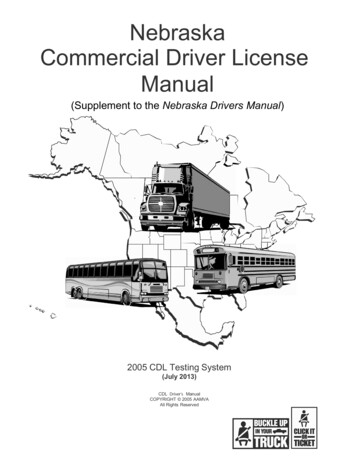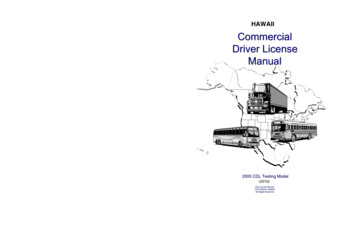
Transcription
HAWAIIHAWAIICommercialDriver LicenseManualCommercial Driver License Manual2005 CDL Testing Model(July2010)2007)(2010)CDL Driver’s ManualCOPYRIGHT AAMVAAll Rights Reserved
COMMERCIAL DRIVER LICENSING OFFICESClosed Saturdays, Sundays and HolidaysCITY AND COUNTY OF HONOLULUCDL Unit, 99-501 Salt Lake Boulevard, Phone 487-5534Hours of Operation. 6:45 a.m. to 3:00 p.m.Testing Hours. 6:45 a.m. to 2:00 p.m.COUNTY OF HAWAIIHilo Police Station, 349 Kapiolani Street, Phone 961-2222West Hawaii Civic Center, 74-5044 Ane Keohokalole Highway, Phone 323-4800Waimea Police Station, Waimea, Phone 887-3087Hours of Operation. 7:45 a.m. to 4:00 p.m.COUNTY OF MAUIKahului Service Center, Maui Mall, 70 E. Kaahumanu Avenue, Suite A17, Phone 270-7363Hana, 4610 Hana Highway, Phone 248-7280, Tuesday and Thursday, 8-11 a.m.Molokai, Mitchell Pauole Center, 100 Ailoa Street, Phone 553-3430Lanai, 717 Fraser Avenue, Phone 565-7878Hours of Operation (except where noted). 8:00 a.m. to 4:00 p.m.Call (808) 270-7363 or visit us at www.mauicounty.govCOUNTY OF KAUAIDepartment of Finance, 4444 Rice Street, Suite 480, Lihue, Phone 241-4242Hours of Operation. 7:45 a.m. to 4:00 p.m.Testing Hours. 8:00 a.m. to 3:00 p.m.This manual was developed through the joint cooperation of the Federal Highway Administration (FHWA) and the American Association of MotorVehicle Administrators (AAMVA). COPYRIGHT AAMVA All Rights ReservedPrinted on 03/2012 by the Hawaii Department of TransportationDOTH2044 03/2012
HAWAII COMMERCIAL DRIVER LICENSE PROGRAMINTRODUCTIONThis manual includes the information needed to pass the commercial driver license(CDL) knowledge and skills tests. Although every effort has been made to ensure accuracy ofthis information, laws and procedures are subject to change.Are There CDL Exemptions?These people do not need a CDL: ACTIVE DUTY MILITARY (including NATIONAL GUARD) with military licenses operatingmilitary vehicles. FEDERAL, STATE AND COUNTY FIREFIGHTERS AND POLICE operating authorized emergencyvehicles. INDIVIDUALS operating motor homes or other vehicles used exclusively to transport personalpossessions or family members, for non-business purposes.How Old Must I Be to Obtain a CDL?You must be age 21 to drive a commercial motor vehicle (CMV). See Section 1, page 1-1, on the definition of aCMV.Do I Need to Meet Medical and Physical Requirements to Receive a CDL?You need to comply with federal and state medical and physical requirements before receiving a CDL. You mustpresent a current medical examiner’s certificate completed by the medical examiner when applying for a CDL.Information on the medical and physical requirements is available at any driver licensing station. A waiver of certainphysical impairment or disease may be available. For federal exceptions or variance, go to www.fmcsa.dot.gov. Tomaintain your CDL status your medical examiner’s certificate must be current. You must submit an updated medicalexaminer’s certificate prior to the expiration date.How Do I Obtain a CDL?When ready to apply for your CDL, go to any of the driver licensing offices listed inside the cover of this manual. Show your driver license. Show proof of age (birth certificate). Show proof of identity, Hawaii residency and social security number (social security card). Show lawful admission into the United States (for hazardous materials endorsement only). Show your physical examination report that certifies you meet medical and physical qualifications. Fill out an application (DOT 4-764) and attach a current color photograph (passport type). Provide information of previous State licenses, including Washington, D.C., held in the previous ten years. Pass the required vision and knowledge tests to obtain an instruction permit. The instruction permit is validfor one year and allows you to practice driving under supervision of a driver who has a CDL for the type ofvehicle you wish to drive. Schedule skills tests and pay the 50 fee. You must pass all three parts of the skills test at the sameappointment. Pay all necessary fees.ii
What Fees Do I Pay?You will be charged: 20- 40 (depending on county) Base operator licenseCDLgeneralknowledgetest 15 5 CDL endorsement test 30 CDL instruction permitCDLskillstests 50(must be paid when scheduling the appointment) 40 (valid for 8 years) CDLAdding CDL privileges, including adding a passenger endorsement, removing a restriction and changing a lower groupdesignation to a higher group designation, requires new skills tests in the appropriate vehicle and fees are charged accordingly.Are there Special Instructions for Skills Testing? You must pass all three parts of the practical test at the same appointment. The order of the tests is: pre-tripinspection; off-road; and road test. Failure of the air brake test is an automatic failure for the pre-trip inspection test.The test will be discontinued at that point. You must pay 50 for the practical test at the time you schedule an appointment for the test, before you take the test. Ifyou fail the test or fail to show up for the test, there is no refund. The 50 is for the complete three-part practical test.If any part is failed, the whole test is failed and the whole test must be rescheduled. No memory aids are allowed during the tests. You may get out of the driver’s seat to check the location of the vehicle only one time per exercise during the off-roadskills test. At the beginning of the test, you will be informed about exiting the vehicle safely, which includes placing thevehicle into neutral/park and setting the parking brake(s). Exit trucks facing the vehicle while maintaining three points ofcontact at all times. If you exit in an unsafe manner, you will be informed again of your responsibility to exit the vehiclesafely. If you exit the vehicle in an unsafe manner (including not securing the vehicle) a second time, an additional tenpoints will be deducted for that exercise for failure to follow instructions. Bus drivers do not need to exit backwards, butthey must hold on to the rails as they exit. One and one-half hours is the maximum time allowed for the entire practical test using a Class B or lower vehicle (pretrip, off-road and road test). If a Class A vehicle is used, the maximum time is two hours. Hawaii will use the random (partial) method of conducting the pre-trip inspection. The basic control skills test alsoinvolves random selection of some maneuvers. If you fail to follow instructions, ten additional points are deducted from your score for that exercise. For instance, ifyou had two points deducted prior to not following instructions, then the points deducted for that exercise total 12. You must wear a seat belt while performing the off-road driving test. School bus doors must be closed when doing the off-road driving test. If you accumulate 13 points during the basic control skills test, the practical test will be discontinued. You will need toreschedule all three parts of the practical test. Hawaii defines a Class A vehicle the same as it is defined in the FMCSR and 286-2, HRS, which is as follows: “Anycombination of vehicles with a gross combination weight rating (GCWR) of 26,001 pounds or more provided theGVWR of the vehicle(s) being towed is in excess of 10,000 pounds.” Hawaii allows simulated railroad crossing and student discharge.What CDL Restrictions Could I Receive?You could receive the following restrictions on your CDL: Code K Code O Code W Code X Code YCDL not valid for operating vehicles equipped with air brakes You will be restricted fromoperating vehicles with air brakes if you do not pass the air brake knowledge test, or if the vehicleyou use for the CDL skills tests is not equipped with air brakes.CDL valid for operating CDL vehicles with automatic and synchromesh transmissions only Youwill be limited from operating commercial vehicles if the vehicle you use for the CDL skills tests isequipped with an automatic or synchromesh transmission.CDL not valid for operating in interstate commerce. Indicates your driver recordcontainsinformation about a medical waiver that allows you to operate in intrastate commerce only.CDL with P endorsement valid in class B or C vehicles only Your passenger endorsement will berestricted to class B and C vehicles if the bus you use for the passenger endorsement skills tests is aclass B bus.CDL with P endorsement valid in class C vehicle only Your passenger endorsement will berestricted to class C vehicles if the bus you use for the passenger endorsement skills tests is a class Cbus.
Code Z Code VClass A CDL not valid for operating tractor-trailer combinations. You will be restricted fromoperating tractor-trailer combinations if the vehicle you use for the class A CDL skills tests is atruck-trailer combination.Indicates there is information about a medical variance on the CDLIS driver record. You must havea medical variance document in your possession when driving a CDL vehicle.What Happens if I Am Convicted of a CDL Disqualifying Offense?If you are convicted of certain traffic violations while operating a CMV, you are subject to stiffer penalties which may result inthe suspension or revocation of your CDL. Your operator license may also be affected, depending on the severity of theviolation.Any traffic violation in a non-commercial motor vehicle resulting in a suspension or revocation of your operator license willalso result in a suspension or revocation of your CDL.MAJOR OFFENSES (HRS 286-240)1. Driving a motor vehicle while under the influence of alcohol, as prescribed by state law.2. Driving a motor vehicle while under the influence of a controlled substance.3. Driving a commercial motor vehicle while the person’s blood alcohol concentration is 0.04% or more.4. Refusing to take an alcohol or drug test as required by a State or jurisdiction under its implied consent laws orregulations.5. Leaving the scene of an accident (driving a motor vehicle).6. A felony involving the use of a motor vehicle, other than “use of a motor vehicle in the commission of a felonyinvolving manufacturing, distributing, or dispensing a controlled substance”.7. Driving a commercial motor vehicle when as a result of prior violations committed operating a CMV, the driver’sCDL is revoked, suspended, or canceled, or the driver is disqualified from operating a CMV.8. Causing a fatality through the negligent operation of a commercial motor vehicle, including but not limited to thecrimes of motor vehicle manslaughter, homicide by motor vehicle and negligent homicide.9. Use of a motor vehicle in the commission of a felony involving manufacturing, distributing, or dispensing a controlledsubstance.Penalties for convictions of Major Offenses (HRS 286-240)Numbers 1-8 above1st major offense2nd and separate incident ofany major offenseAnd the vehicle was not transportingLifetime disqualificationhazardous materials required to beplacarded: 1- year disqualificationAnd the vehicle was transportinghazardous materials required to beplacarded: 3- year disqualificationIncident afterreinstatementLifetime disqualificationnot eligible forreinstatementNumber 9 aboveLifetime disqualification, not eligible for 10 year reinstatementSERIOUS TRAFFIC VIOLATIONS (HRS 286-231)1. Speeds excessively, involving any speed of 15 mph or more above the posted speed limit.2. Drives recklessly, as defined by State or local law or regulation, including but not limited to offenses of driving amotor vehicle in willful or wanton disregard for the safety of persons or property.3. Makes improper or erratic traffic lane changes.4. Follows the vehicle ahead too closely.5. Violates State or local law relating to motor vehicle traffic control arising in connection with a fatal accident.6. Driving a CMV without obtaining a CDL.7. Driving a CMV without a current CDL in the driver’s possession.8. Driving a CMV without the proper class of CDL and/or endorsements for the specific vehicle group being operated orfor the passengers or type of cargo being transported.iiiiii
Penalties for convictions of Serious Offenses (HRS 286-240)1st conviction2nd conviction of a separate incidentof an offense in this table during a 3year periodNo disqualification60 days disqualification3rd or subsequent conviction of anyoffense in this table in a separateincident during a 3-year period120 days disqualificationRAILROAD-HIGHWAY GRADE CROSSING OFFENSES (HRS 286-240)The driver operates a commercial motor vehicle in violation of a federal, state or local law and:1. The driver is not required to always stop, but fails to slow down and check that tracks are clear of an approachingtrain.2. The driver is not required to always stop, but fails to stop before reaching the crossing, if the tracks are not clear.3. The driver is always required to stop, but fails to stop before driving onto the crossing.4. The driver fails to have sufficient space to drive completely through the crossing without stopping.5. The driver fails to obey a traffic control device or the directions of an enforcement official at the crossing.6. The driver fails to negotiate a crossing because of insufficient under-carriage clearance.Penalties for convictions of RRGC Offenses1st conviction2nd conviction of any offense in this table ina separate incident within a 3-year period.No less than 60 daysNo less than 120 days CMV disqualification3rd or subsequent conviction of anyoffense in this table in a separateincident within a 3-year periodNo less than 1- year CMVdisqualificationVIOLATING OUT-OF-SERVICE ORDERS1. Driving while out of service order is in effect and transporting 16 or more passengers, including the driver and/ortransporting hazardous materials that require a placard.2. General driving while out of service order is in effect.Penalties for convictions of Violation of an Out-of-Service Order (HRS 286-240)1st conviction2nd conviction of a separateincident of an offense in thistable during a 10-year periodFor a conviction in a HAZMAT CMV and/or a Passenger CMV180 days to 2- year3 to 5- year disqualificationdisqualificationFor a conviction in a CMV that was not a Passenger CMV or a HAZMAT CMV180 days to 1- year2 to -5 year disqualificationdisqualification3rd or subsequent conviction ofa separate incident of anoffense in this table, during a10-year period3 to 5- year disqualificationIMMINENT HAZARD DISQUALIFICATION (HRS 231)FMCSA has the authority to remove a CDL driver by determining the driver is an imminent hazard, which it defines as“the existence of a condition that presents a substantial likelihood that death, serious illness, severe personal injury, or asubstantial endangerment to health, property, or the environment may occur before the completion date of a formalproceeding begun to lessen the risk of that death, illness, injury or endangerment”.Allowing the driver to continue to operate a CMV would create an imminent hazard.Penalty (HRS 286-240)Emergency disqualification because driver posed an imminent hazard --- up to one- year disqualificationDISQUALIFICATION FOR A FALSIFY OFFENSE (HRS 286-240)Misrepresentation of identity or other facts on application for driver license (includes driver’s license, CDL and instructionpermit).Penalty60 day disqualification4iv
DISQUALIFICATION FOR FAILING TO SURRENDER THE HAZMAT ENDORSEMENT (HRS 286-238.5)Failure to surrender HAZMAT endorsement as required by the USA PATRIOT ActPenaltyIndefinite disqualification until CDL with HAZMAT endorsement is surrenderedWhat are the CDL Consequences for Violations Committed While Operating Noncommercial Vehicles?Your CDL is a special privilege attached to your operator license. If, while operating any kind of motor vehicle, including yourpersonal car, you commit a violation that results in the suspension or revocation of your operator license, your CDL will besuspended for the same period.What is a Hawaii Driver History Record?Your Hawaii Driver History Record includes driver identification information, driver’s license information,and the driver’s history of convictions, withdrawals, and (optionally) accidents. It can be obtained for alldrivers regardless of the class license.Some of the reasons for obtaining the driver history record include: The businesses that employ drivers with various license classes may be required to do pre employmentand annual driving record checks even though their driver is not required to hold a CDL. A CDL driver may want to check if medical examiner certificate (MEC) information is current. Application for an intrastate medical waiver requires a certified copy of the driver history record.You may obtain your Hawaii Driver History Record by visiting .
Table Of ContentsIntroduction . 1-1Driving Safely . 2-1Transporting Cargo Safely . 3-1Transporting Passengers Safely . 4-1Air Brakes . 5-1Combination Vehicles . 6-1Doubles and Triples . 7-1Tank Vehicles . 8-1Hazardous Materials. 9-1School Bus . 10-1Pre-Trip Vehicle Inspection . 11-1Basic Vehicle Control Skills Test . 12-1On-Road Driving . 1
2005 Model Commercial Driver’s License ManualDo You Need a CDL?Section 1INTRODUCTIONNoThis Section Covers Commercial Driver License TestsDriver DisqualificationsOther Safety RulesYesIs the vehicleacombinationvehicletowing a unitover 10,000poundsGVWR?There is a federal requirement that each statehave minimum standards for the licensing ofcommercial drivers.This manual provides driver license testinginformation for drivers who wish to have acommercial driver license (CDL). This manual doesNOT provide information on all the federal andstate requirements needed before you can drive acommercial motor vehicle (CMV). You may have tocontact your state driver licensing authority foradditional information.Does thesingleYesvehicle havea GVWRover 26,000pounds?Any single vehicle with a gross vehicle weightrating (GVWR) of 26,001 pounds or more.A combination vehicle with a gross combinationweight rating of 26,001 or more pounds, if thetrailer(s) has a GVWR of 10,001 or more pounds.Youneed aClass ACDL.YesYouneed aClass BCDL.NoIs the vehicledesigned tocarry 16 ormore people(includingthe driver)?A vehicle designed to transport 16 or morepassengers (including the driver).Any size vehicle which requires hazardousmaterial placards or is carrying material listed asa select agent or toxin in 42 CFR part 73.Federal regulations through the Department ofHomeland Security require a background checkand fingerprinting for the Hazardous Materialsendorsement. Contact your local department ofdriver licensing for more information.YesYouneed aClass CCDL.NoNoDoes thevehiclerequirehazardousmaterialplacards ortransport aselect agentor toxin?(Your state may have additional definitions ofCMVs.)Section 1 - IntroductionYesNoYou must have a CDL to operate:To get a CDL, you must pass knowledge and skillstests. This manual will help you pass the tests.This manual is not a substitute for a truck drivertraining class or program. Formal training is themost reliable way to learn the many special skillsrequired for safely driving a large commercialvehicle and becoming a professional driver in thetrucking industry. Figure 1.1 helps you determine ifyou need a CDLDoes the vehicle orcombination of vehicleshave a manufacturer’sweight rating (GVWR orGCVWR)) over 26,000 lbspounds?YesYouneed aClass CCDL.NoYou DO NOTneed a CDL.NOTE:A bus may be Class A, B, or C depending on whetherthe GVWR is over 26,000 pounds or is a combinationvehicle.Figure 1.1Page 1-1
2005 Model Commercial Driver’s License Manual1.1 – Commercial Driver License Tests1.1.1 – Knowledge TestsYou will have to take one or more knowledge tests,depending on what class of license and whatendorsements you need. The CDL knowledgetests include:The general knowledge test, taken by allapplicants.The passenger transport test, taken by all busdriver applicants.The air brakes test, which you must take if yourvehicle has air brakes, including air overhydraulic brakes.similar. The examiner will tell you how each controltest is to be done.On-road Test. You will be tested on your skill tosafely drive your vehicle in a variety of trafficsituations. The situations may include left and rightturns, intersections, railroad crossings, curves, upand down grades, single or multi-lane roads,streets, or highways. The examiner will tell youwhere to drive.Figure 1.2 details which sections of this manualyou should study for each particular class oflicense and for each endorsement.What Sections Should You Study?LICENSEENDORSEMENTTYPE2XXX3XXX1.1.2 – Skills Tests6XIf you pass the required knowledge test(s), you cantake the CDL skills tests. There are three types ofgeneral skills that will be tested: pre-trip inspection,basic vehicle control, and on-road driving. Youmust take these tests in the type of vehicle forwhich you wish to be licensed. Any vehicle thathas components marked or labeled cannot beused for the Pre-Trip Inspection Test.7Section 1 - IntroductionXXXBasic Vehicle Control. You will be tested on yourskill to control the vehicle. You will be asked tomove your vehicle forward, backward, and turn itwithin a defined area. These areas may be markedwith traffic lanes, cones, barriers, or somethingX45*Pre-trip Vehicle Inspection. You will be tested tosee if you know whether your vehicle is safe todrive. You will be asked to do a pre-trip inspectionof your vehicle and explain to the examiner whatyou would inspect and why.XSchool BusXPassengerXTank VehiclesXDouble / Triple1HazardousMaterialsThe School Bust test, required if you want todrive a school bus.Class CThe doubles/triples test, required if you want topull double or triple trailers.Class BThe tanker test, required if you want to haul aliquid or liquid gas in a permanently mountedcargo tank rated at 119 gallons or more or aportable tank rated at 1,000 gallons or more.Sections to StudyThe hazardous materials test, required if youwant to haul hazardous materials as defined in49 CFR 383.5. In order to obtain thisendorsement you are also required to pass aTransportation Security Administration (TSA)background check.Class AThe combination vehicles test, which is requiredif you want to drive combination vehicles.XXXXXX8X9XX10X11XXXXX12XXXXX13XXXXX*Study section 5 if you plan to operate vehiclesequipped with air brakes.Figure 1.2 – What to StudyPage 1-2
2005 Model Commercial Driver’s License Manual1.2 – CDL Disqualifications1.2.1 – GeneralYou may not drive a commercial motor vehicle ifyou are disqualified for any reason.1.2.2 – Alcohol, Leaving the Scene of anAccident, and Commission of a FelonyIt is illegal to operate a CMV if your blood alcoholconcentration (BAC) is .04% or more. If youoperate a CMV, you shall be deemed to havegiven your consent to alcohol testing.You will lose your CDL for at least one year for afirst offense for:Driving a CMV if your blood alcoholconcentration is .04% or higher.Driving a CMV under the influence of alcohol.Refusing to undergo blood alcohol testing.Driving a CMV while under the influence of acontrolled substance.without the properendorsements.classofCDLand/orYou will lose your CDL:For at least 60 days if you have committed twoserious traffic violations within a three-yearperiod involving a CMV.For at least 120 days for three or more serioustraffic violations within a three-year periodinvolving a CMV.1.2.4 – Violation of Out-of-Service OrdersYou will lose your CDL:[For at least 90 days if you have committed yourfirst violation of an out-of-service order.For at least one year if you have committed twoviolations of an out-of-service order in a ten-yearperiod.For at least three years if you have committedthree or more violations of an out-of-serviceorder in a ten-year period].Leaving the scene of an accident involving aCMV.1.2.5 – Railroad-highway Grade CrossingViolationsCommitting a felony involving the use of a CMV.You will lose your CDL:Driving a CMV when the CDL is suspended.For at least 60 days for your first violation.Causing a fatality through negligent operation ofa CMV.For at least 120 days for your second violationwithin a three-year period.You will lose your CDL for at least three years ifthe offense occurs while you are operating a CMVthat is placarded for hazardous materials.You will lose your CDL for life for a second offense.You will lose your CDL for life if you use a CMV tocommit a felony involving controlled substances.You will be put out-of-service for 24 hours if youhave any detectable amount of alcohol under.04%.1.2.3 – Serious Traffic ViolationsSerious traffic violations are excessive speeding(15 mph or more above the posted limit), recklessdriving, improper or erratic lane changes, followinga vehicle too closely, traffic offenses committed ina CMV in connection with fatal traffic accidents,driving a CMV without obtaining a CDL or having aCDL in the driver’s possession, and driving a CMVSection 1 - IntroductionFor at least one year for your third violationwithin a three-year period.These violations include violation of a federal, stateor local law or regulation pertaining to one of thefollowing six offenses at a railroad-highway gradecrossing:For drivers who are not required to always stop,failing to stop before reaching the crossing if thetracks are not clear.For drivers who are not required to always stop,failing to slow down and check that the tracksare clear of an approaching train.For drivers who are always required to stop,failing to stop before driving onto the crossing.For all drivers failing to have sufficient space todrive completely through the crossing withoutstopping.For all drivers failing to obey a traffic controldevice or the directions of an enforcementofficial at the crossing.Page 1-3
2005 Model Commercial Driver’s License ManualFor all drivers failing to negotiate a crossingbecause of insufficient undercarriage clearance.1.2.6 – Hazardous Materials EndorsementBackground Check and DisqualificationsIf you require a hazardous materials endorsementyou will be required to submit your fingerprints andbe subject to a background check.You will be denied or you will lose your hazardousmaterials endorsement if you:Are not a lawful permanent resident of theUnited States.Renounce your United States citizenship.Are wanted or under indictment for certainfelonies.Have a conviction in military or civilian court forcertain felonies.Have been adjudicated as a mental defective orcommitted to a mental institution.Are considered to pose a security threat asdetermined by the Transportation SecurityAdministration.The background check procedures vary fromjurisdiction to jurisdiction. Your licensing agencywill provide you with all the information you needto complete the required TSA background checkprocedures.1.2.7 – Traffic Violations in Your PersonalVehicleThe Motor Carrier Safety Improvement Act(MCSIA) of 1999 requires a CDL holder to bedisqualified from operating a commercial motorvehicle if the CDL holder has been convicted ofcertain types of moving violations in theirpersonal vehicle.If your privilege to operate your personal vehicle isrevoked, cancelled, or suspended due to violationsof traffic control laws (other than parking violations)you will also lose your CDL driving privileges.If your privilege to operate your personal vehicle isrevoked, cancelled, or suspended due to alcohol,controlled substance or felony violations, you willlose your CDL for 1 year. If you are convicted of asecond violation in your personal vehicle or CMVyou will lose your CDL for life.If your license to operate your personal vehicle isrevoked, cancelled, or suspended you may notobtain a ―hardship‖ license to operate a CMV.Section 1 - Introduction1.3 – Other CDL RulesThere are other federal and state rules that affectdrivers operating CMVs in all states. Among themare:You cannot have more than one license. If youbreak this rule, a court may fine you up to 5,000 or put you in jail and keep your homestate license and return any others.You must notify your employer within 30 days ofconviction for any traffic violations (exceptparking). This is true no matter what type ofvehicle you were driving.You must notify your moto
What Fees Do I Pay? You will be charged: Base operator license 20- 40 (depending on county) CDL general knowledge test 15 CDL endorsement test 5 CDL instruction permit 30 CDL skills tests 50 (must be paid when scheduling the appointment) CDL 40 (valid for 8 years) Adding CDL privileges, including adding a passenger endorsement, removing a restriction and changing .
